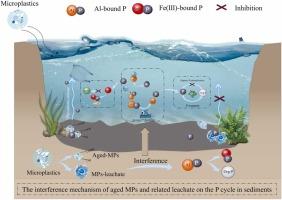老化微塑料及其相关渗滤液对沉积物中磷转化和释放的不同影响
IF 11.3
1区 环境科学与生态学
Q1 ENGINEERING, ENVIRONMENTAL
引用次数: 0
摘要
微塑料(MPs)在淡水沉积物中积累和老化,释放出可能改变沉积物营养循环的渗滤液。虽然磷(P)对淡水富营养化至关重要,但以前的研究很少关注MPs渗滤液。本文研究了聚乙烯(PE)、聚苯乙烯(PS)、聚氯乙烯(PVC)及相关渗滤液对沉积物磷循环的影响。结果表明,老化的MPs和渗滤液通过诱导DOM成分和结构以及微生物群落来调节磷循环功能基因的表达,从而影响磷循环。老化MP和渗滤液影响沉积物P的主要机制是促进al结合的P向Fe (III)结合的P和有机P的转化。含有微生物可利用有机物质的渗滤液对al结合的P向有机P的转化作用更为显著。此外,培养和吸附实验表明,老化MP能促进沉积物中P的释放,而渗滤液则抑制沉积物中P的释放。不同年龄的MPs和渗滤液对磷释放的影响不同。与对照组(0.496 mg/L)相比,5% PE-MPs的上覆水体磷浓度最高(0.659 mg/L), 1% LPE的上覆水体磷浓度最低(0.189 mg/L)。这些结果为老年MPs和渗滤液参与淡水养分循环提供了新的见解。本文章由计算机程序翻译,如有差异,请以英文原文为准。

Varied influence of aged microplastics and related leachates on phosphorus transformation and release from the sediments
Microplastics (MPs) accumulate and age in freshwater sediments, releasing leachates that may alter sediment nutrient cycling. While phosphorus (P) is crucial for freshwater eutrophication, previous studies have rarely focused on MPs leachates. Herein, this work investigated the effects of polyethylene (PE), polystyrene (PS), polyvinyl chloride (PVC), and related leachates on the sediment P cycling. Results indicated that aged MPs and leachates regulated the expression of P cycling functional genes via inducing DOM components and structures, and microbial communities, thereby affecting the P cycling. The primary mechanism by which aged MPs and leachates affect sediment P involved facilitating the transformation of Al-bound P into Fe (III)-bound P and organic P. Leachates containing microbial-utilizable organic matter exerted a more significant impact on converting Al-bound P into organic P. Besides, incubation and adsorption experiments revealed that aged MP could enhance P release from sediments while leachate inhibited. The effects of different aged MPs and leachate on P release vary. Compared to the control group (0.496 mg/L), P concentration in the overlying water was the highest in 5% PE-MPs (0.659 mg/L) and the lowest in 1% LPE (0.189 mg/L). These results provided new insights into the involvement of aged MPs and leachates in freshwater nutrient cycling.
求助全文
通过发布文献求助,成功后即可免费获取论文全文。
去求助
来源期刊

Journal of Hazardous Materials
工程技术-工程:环境
CiteScore
25.40
自引率
5.90%
发文量
3059
审稿时长
58 days
期刊介绍:
The Journal of Hazardous Materials serves as a global platform for promoting cutting-edge research in the field of Environmental Science and Engineering. Our publication features a wide range of articles, including full-length research papers, review articles, and perspectives, with the aim of enhancing our understanding of the dangers and risks associated with various materials concerning public health and the environment. It is important to note that the term "environmental contaminants" refers specifically to substances that pose hazardous effects through contamination, while excluding those that do not have such impacts on the environment or human health. Moreover, we emphasize the distinction between wastes and hazardous materials in order to provide further clarity on the scope of the journal. We have a keen interest in exploring specific compounds and microbial agents that have adverse effects on the environment.
 求助内容:
求助内容: 应助结果提醒方式:
应助结果提醒方式:


